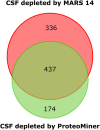Affinity depletion versus relative protein enrichment: a side-by-side comparison of two major strategies for increasing human cerebrospinal fluid proteome coverage
- PMID: 30890900
- PMCID: PMC6390343
- DOI: 10.1186/s12014-019-9229-1
Affinity depletion versus relative protein enrichment: a side-by-side comparison of two major strategies for increasing human cerebrospinal fluid proteome coverage
Abstract
Cerebrospinal fluid (CSF) is in direct contact with the central nervous system. This makes human CSF an attractive source of potential biomarkers for neurologic diseases. Similarly to blood plasma, proteomic analysis of CSF is complicated by a high dynamic range of individual protein concentrations and by the presence of several highly abundant proteins. To deal with the abundant human CSF proteins, methods developed for blood plasma/serum are routinely used. Multiple affinity removal systems and protein enrichment of less abundant proteins using a combinatorial peptide ligand library are among the most frequent approaches. However, their relative impact on CSF proteome coverage has never been evaluated side-by-side in a single study. Therefore, we explored the effect of CSF depletion using MARS 14 cartridge and ProteoMiner ligand library on the number of CSF proteins identified in subsequent LC-MS/MS analysis. LC-MS/MS analysis of crude (non-treated) CSF provided roughly 500 identified proteins. Depletion of CSF by MARS 14 cartridge increased the number of identifications to nearly 800, while treatment of CSF using ProteoMiner enabled identification of 600 proteins. To explore the potential losses of CSF proteins during the depletion process, we also analyzed the "waste" fractions generated by both methods, i.e., proteins retained by the MARS 14 cartridge, and the molecules present in the flow-through fraction from ProteoMiner. More than 250 proteins were bound to MARS 14 cartridge, 100 of those were not identified in the corresponding depleted CSF. Similarly, analysis of the waste fraction in ProteoMiner workflow provided almost 70 unique proteins not found in the CSF depleted by the ligand library. Both depletion strategies significantly increased the number of identified CSF proteins compared to crude CSF. However, MARS 14 depletion provided a markedly higher number of identified proteins (773) compared to ProteoMiner (611). Further, we showed that CSF proteins are lost due to co-depletion (MARS 14) or exclusion (ProteoMiner) during the depletion process. This suggests that the routinely discarded "waste" fractions contain proteins of potential interest and should be included in CSF biomarker studies.
Keywords: Biomarkers; CNS; Cerebrospinal fluid; Depletion; LC–MS/MS; Mass spectrometry.
Figures





Similar articles
-
Affinity Capture Enrichment versus Affinity Depletion: A Comparison of Strategies for Increasing Coverage of Low-Abundant Human Plasma Proteins.Int J Mol Sci. 2020 Aug 17;21(16):5903. doi: 10.3390/ijms21165903. Int J Mol Sci. 2020. PMID: 32824511 Free PMC article.
-
A Versatile Workflow for Cerebrospinal Fluid Proteomic Analysis with Mass Spectrometry: A Matter of Choice between Deep Coverage and Sample Throughput.Methods Mol Biol. 2019;2044:129-154. doi: 10.1007/978-1-4939-9706-0_9. Methods Mol Biol. 2019. PMID: 31432411
-
Assessment approach for evaluating high abundance protein depletion methods for cerebrospinal fluid (CSF) proteomic analysis.J Proteome Res. 2007 Sep;6(9):3739-51. doi: 10.1021/pr070293w. Epub 2007 Aug 16. J Proteome Res. 2007. PMID: 17696521
-
Insights into the human brain proteome: Disclosing the biological meaning of protein networks in cerebrospinal fluid.Crit Rev Clin Lab Sci. 2017 May;54(3):185-204. doi: 10.1080/10408363.2017.1299682. Epub 2017 Apr 10. Crit Rev Clin Lab Sci. 2017. PMID: 28393582 Review.
-
Depletion of highly abundant proteins from human cerebrospinal fluid: a cautionary note.Mol Neurodegener. 2015 Oct 15;10:53. doi: 10.1186/s13024-015-0050-7. Mol Neurodegener. 2015. PMID: 26471478 Free PMC article. Review.
Cited by
-
Deep Proteome Analysis of Cerebrospinal Fluid from Pediatric Patients with Central Nervous System Cancer.J Proteome Res. 2024 Nov 1;23(11):5048-5063. doi: 10.1021/acs.jproteome.4c00471. Epub 2024 Oct 9. J Proteome Res. 2024. PMID: 39382389 Free PMC article.
-
Proteomic Discovery and Validation of Novel Fluid Biomarkers for Improved Patient Selection and Prediction of Clinical Outcomes in Alzheimer's Disease Patient Cohorts.Proteomes. 2022 Aug 1;10(3):26. doi: 10.3390/proteomes10030026. Proteomes. 2022. PMID: 35997438 Free PMC article. Review.
-
Low-Abundance Protein Enrichment for Medical Applications: The Involvement of Combinatorial Peptide Library Technique.Int J Mol Sci. 2023 Jun 19;24(12):10329. doi: 10.3390/ijms241210329. Int J Mol Sci. 2023. PMID: 37373476 Free PMC article. Review.
-
Targeted mass spectrometry to quantify brain-derived cerebrospinal fluid biomarkers in Alzheimer's disease.Clin Proteomics. 2020 May 29;17:19. doi: 10.1186/s12014-020-09285-8. eCollection 2020. Clin Proteomics. 2020. PMID: 32514259 Free PMC article.
-
Urinary biomarkers for amyotrophic lateral sclerosis: candidates, opportunities and considerations.Brain Commun. 2023 Oct 24;5(6):fcad287. doi: 10.1093/braincomms/fcad287. eCollection 2023. Brain Commun. 2023. PMID: 37946793 Free PMC article. Review.
References
LinkOut - more resources
Full Text Sources
Other Literature Sources
Miscellaneous
